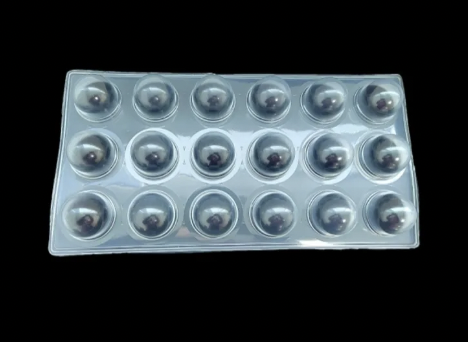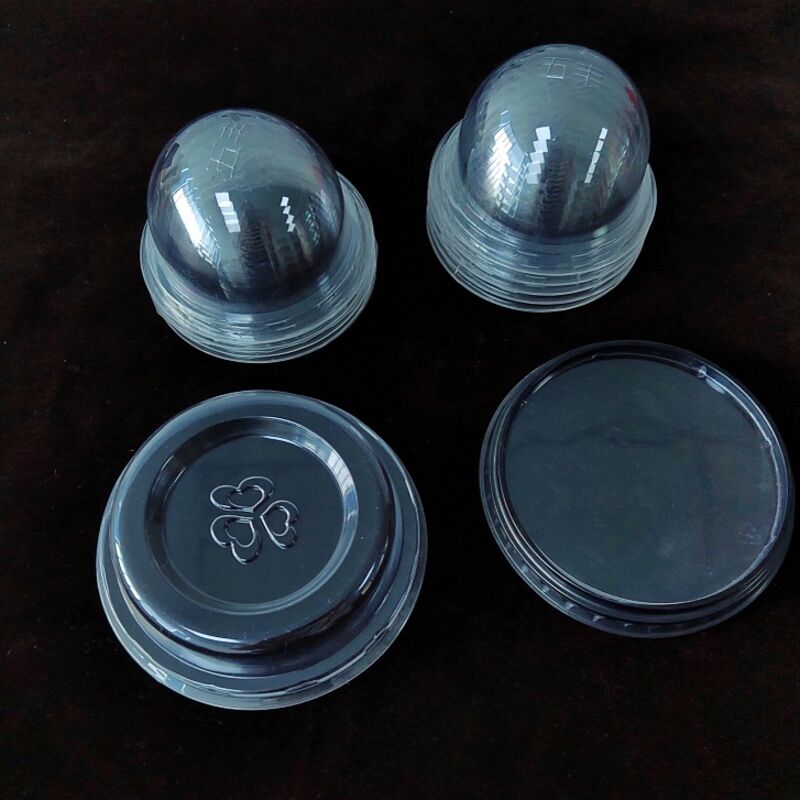최고의 효율성을 위한 고명료 재질 선택하기
소매 가시성에서 PVC와 PET의 이점
패키징 측면에서 PVC 및 PET 소재를 사용하면 제품이 매장 진열대에서 훨씬 돋보일 수 있습니다. 이러한 소재의 투명성은 소비자가 내용물을 명확하게 볼 수 있게 해주어 경쟁 제품들 속에서 제품의 가시성을 크게 높여줍니다. 일부 시장 조사에 따르면 PVC나 PET 같은 투명 플라스틱 포장재로 포장된 제품은 쇼핑객의 주의를 약 24% 더 끌어당기는 것으로 나타났으며, 이는 자연스럽게 더 높은 판매 실적으로 이어질 수 있습니다. 또한 이러한 소재는 무게가 가벼워 취급이 용이하면서도 포장 내 제품을 보호할 만큼 충분한 강도를 갖추고 있어 균형 잡힌 성능을 제공합니다. 그래서 다양한 제품 범주에서 블리스터 패키지에 이 소재들이 널리 사용되고 있는 것입니다. 포장은 전시 효과도 뛰어나고, 동시에 내용물을 적절히 보호하는 기능도 충분히 수행합니다.
지속 가능한 포장재에 대해 이야기할 때 많은 기업들이 PVC와 PET이 실제로 꽤 잘 작동하면서도 제품 내부를 볼 수 있게 해줘서 좋은 선택이 되고 있습니다. 이러한 플라스틱은 뛰어난 투명도를 지녀 매장 진열대에서 브랜드가 돋보이게 하고, 소비자가 구매 전 제품의 세부 정보를 확인할 수 있게 해줍니다. 흥미로운 점은 이 소재들이 실제로 얼마나 다용도로 사용될 수 있는지입니다. 이들은 다양한 형태와 크기로 성형이 가능하기 때문에 제조사가 복잡한 모양의 제품을 보호하기 위해 추가적인 완충재를 사용할 필요가 없습니다. 이러한 유연성 덕분에 포장재 원가와 폐기물 비용을 절감할 수 있어 점점 더 많은 브랜드들이 이 소재를 채택하고 있습니다. 게다가 요즘 소비자들은 포장을 열지 않고도 무엇을 구입하는지 명확히 확인할 수 있다는 점에서 투명 포장재를 선호하는 경향이 있습니다.
최적의 투명성을 위한 열 성형 vs 냉간 성형
명확한 포장재를 제작할 때 제조사들은 흔히 열성형 또는 냉간성형 방식을 선택합니다. 열성형의 경우 플라스틱 시트를 유연해질 때까지 가열한 뒤 복잡한 형태로 성형하면서도 투명도를 크게 잃지 않습니다. 이 방식은 제품 자체를 가리지 않고 매력적인 포장으로 내용물을 바로 확인할 수 있게 해주기 때문에 진열이 중요한 제품에 적합합니다. 냉간성형은 완전히 다른 접근 방식을 사용합니다. 이 방식은 더 견고하고 보호 기능이 뛰어난 포장을 제작할 수 있어 운송 또는 보관 중 손상되기 쉬운 제품에 이상적입니다. 추가적인 강성을 통해 신선도가 중요한 제품이 매장 진열대에서 더 오랫동안 신선하게 유지될 수 있기 때문에 식품 회사들이 민감한 제품에 이 방식을 선호하는 이유입니다.
연구에 따르면 기업이 열성형과 냉간성형 방식 중 하나를 선택할 때는 포장의 투명도와 매장 진열 시 제품의 품질을 결정하게 됩니다. 외관이 특히 중요한 제품의 경우 열성형이 가장 적합한데, 이는 높은 비용에도 불구하고 많은 뷰티 브랜드와 소비자 가전 제조사들이 이 방식을 채택하고 있는 이유입니다. 반면, 의약품 병이나 간식 포장지와 같이 습기와 산소로부터 내용물을 보호해야 하는 제품의 경우 냉간성형이 필수적입니다. 올바른 방식을 선택하면 포장이 제품을 충분히 드러낼 수 있을 만큼 투명하면서도 내용물에 따라 적절한 보호 기능을 제공할 수 있습니다. 많은 포장 엔지니어들이 다양한 시장에서 요구하는 외관 조건과 기능적 요구사항 사이의 균형을 맞추는 방식을 결정하기 전에 두 가지 옵션을 수 시간 동안 테스트합니다.
물질 효율성을 위한 정밀 엔지니어링
버블 포장용 맞춤 몰드를 설계하는 것은 불필요한 자재 낭비를 줄이고 생산 공정을 보다 효율적으로 운영하는 데 중요한 역할을 합니다. CAD 소프트웨어에 투자하는 제조사들은 보다 정밀하게 몰드를 제작할 수 있기 때문에 불필요한 플라스틱 폐기물을 줄이는 데 기여할 수 있습니다. 제품이 이러한 특수 몰드에 정확하게 들어맞을 경우 제조 과정에서 자연스럽게 버려지는 자재가 줄어듭니다. 또한 이러한 맞춤형 몰드는 원자재를 절약하면서도 제품 보호에 탁월한 성능을 발휘합니다. 업계 자료에 따르면 정밀 몰드를 사용하는 기업들은 일반적으로 스크랩 발생률을 20~30%까지 낮출 수 있으며, 이는 장기적으로 재료 비용 절감으로 이어집니다. 제품을 안전하게 보호하는 것을 넘어, 우수한 몰드 설계는 현대 기술의 발전을 바탕으로 한 자원 관리 측면에서도 매우 현명한 접근 방식이라 할 수 있습니다.
제품별 보호를 위한 구멍 모양 맞춤설계
맞춤형 캐비티 형태를 제작하는 것은 블리스터 플라스틱 포장 내에서 특정 제품에 맞는 보호 기능을 제공하는 데 중요한 역할을 합니다. 기업이 이러한 캐비티를 보호가 필요한 제품에 정확하게 맞도록 설계할 때는 크기뿐 아니라 제품의 민감도도 고려하여 운송 및 취급 중 손상을 방지할 수 있습니다. 각 제품의 고유한 특성을 고찰함으로써 제조사는 불필요한 플라스틱 낭비 없이 제품을 단단히 감싸는 몰드를 제작할 수 있습니다. 일부 연구에 따르면 캐비티 형태를 적절히 설계하면 포장재 사용량을 약 15%까지 줄일 수 있다고 합니다. 이러한 세심한 설계 작업은 포장이 효과적이면서도 친환경적이기 위해 왜 맞춤형 설계가 중요한지를 보여주는 사례입니다. 결국 이러한 맞춤형 캐비티는 현대 블리스터 포장에서 우수한 설계와 환경적 책임감이 만나는 지점이라 할 수 있습니다.
자동화된 밀봉 프로세스를 통한 비용 절감
고속 열 밀봉 시스템
고속 열풍기 장비는 사이클 시간을 단축시켜 동일한 시간 내에 더 많은 제품을 생산할 수 있기 때문에 생산 방식을 바꿔놓습니다. 이 기계들은 자동으로 포장 밀봉을 처리하기 때문에 모든 포장이 일관되고 결함 없이 밀봉될 수 있습니다. 이는 식품이나 의약품과 같이 안전을 위해 정확한 밀봉이 필요한 경우 특히 중요합니다. 또한 자동화가 진행되면 공정이 더욱 원활해지기 때문에 기업은 비용을 절감할 수 있습니다. 지난해 제조 저널에 따르면 고속 밀봉 장비를 도입한 기업들은 포장 비용이 최대 30%까지 감소하기도 했습니다. 포장 작업을 개선하려는 제조업체의 경우 이러한 기술에 투자하는 것이 현대 제조업의 요구에 부응하면서도 경영 측면에서도 매우 합리적인 선택이 됩니다.
로봇 통합을 통한 인건비 절감
로봇을 씰링 작업에 도입하면 인건비를 크게 절감할 수 있습니다. 이러한 기계들은 인간이 할 수 있는 속도와 정확성보다 훨씬 뛰어난 성능을 보입니다. 기업이 로봇 시스템에 투자할 때 단순히 인건비 절약만을 고려하는 것은 아닙니다. 장기적으로 오류와 자재 낭비를 줄이는 전략적인 선택이기도 합니다. 일부 제조업체는 자동화된 포장 라인으로 전환한 지 몇 달 만에 인건비를 40~50%까지 절감하기도 했습니다. 이러한 실제 성과들이 많은 기업들이 로봇 도입으로 방향을 전환하고 있는 이유입니다. 비용 절감을 넘어서 자동화 시스템은 제품 품질 향상에도 기여하여 장기적으로는 불량률 감소와 고객 만족도 증가로 이어지고 있습니다.
고속 밀봉 시스템 및 로봇 통합과 같은 자동화 솔루션을 포장 분야에 적용하면 현대 산업 표준에 부합할 뿐만 아니라 운영 비용을 크게 줄임으로써 경쟁 우위를 확보할 수 있습니다.
퍼포레이션 설계로 사용성을 향상시키기
소비자가 사용하기 쉬운 접근점 설계
일반 사람들이 포장을 쉽게 열 수 있도록 디자이너들은 사람들이 가위나 힘을 사용하지 않고도 내용물을 꺼낼 수 있도록 작은 찢는 선이나 홈을 만드는 데 집중합니다. 이러한 포장 기술은 실제로 제품을 사용하기 쉽게 만들 뿐만 아니라 시장 조사 보고서에서 우리가 보는 고객 만족도를 높이는 이중적 효과를 가지고 있습니다. 예를 들어, 알약이나 작은 물건을 포장하는 데 사용되는 블리스터 팩은 미리 홈이 파인 가장자리를 통해 누구나 쉽게 열 수 있도록 되어 있습니다. 포장을 열기 위해 애쓰는 것을 싫어하는 소비자들에게 이러한 편리함은 매우 중요합니다. 또한 이러한 세심한 디자인 요소는 제조사가 어린이 안전 및 우발적 개봉 방지와 관련된 다양한 안전 규정을 준수하는 데에도 도움이 되며, 소비자에게 구매한 제품을 이용할 때 안정감을 줍니다.
보안과 쉬운 개봉의 균형 맞추기
패키지의 보안성을 확보하면서도 개봉이 용이하도록 적절한 균형을 맞추는 것은 여전히 디자이너들에게 큰 과제이다. 이는 도난 방지는 물론 사용자 친화성을 유지하려는 목적에서 중요하다. 그러나 이 두 마케팅 요소를 동시에 만족시키는 스마트한 접근 방식들이 등장하고 있다. 예를 들어 간편하게 개봉할 수 있는 포장 형태인 스낵 봉지의 찢는 테이프(strip)가 좋은 예다. 이러한 작은 홈(small perforations)은 제품의 안전성은 유지하면서도 소비자가 제품에 접근하는 데 불편함이 없다. 최근 소비자 행동 양상에 대한 연구에 따르면, 이 두 가지 측면을 모두 관리하는 브랜드는 장기적으로 더 나은 매출 성과를 보이는 것으로 나타났다. 소비자들은 제품 내부를 보호하면서도 매번 개봉 시 불편함을 주지 않는 포장을 선호하는 경향이 있다. 이러한 기본적인 사실을 중심으로 포장 산업은 끊임없이 진화하고 있으며, 우수한 디자인은 실용적 고려사항과 소비자의 감정적 반응을 동시에 만족시켜야 한다는 점이 명확해지고 있다.
브랜드 성공을 위한 라벨링 호환성 테스트
프린팅 시스템의 사전 배포 검사
어떤 라벨링 시스템을 도입하기 전에 호환성 테스트를 수행하는 것은 향후 비용이 많이 드는 실수를 피하기 위해 합리적인 접근입니다. 저희의 프로세스는 라벨이 다양한 환경 요인에 노출되었을 때 제대로 부착될 수 있는지를 확인합니다. 이는 라벨의 수명과 브랜드가 고객에게 보이는 이미지 모두에 영향을 미칩니다. 저희는 실제 환경에서 발생할 수 있는 온도 변화, 습도 수준, 그 외 자연에서 발생하는 여러 요인에 대해 재료가 어떻게 견디는지를 검증하기 위해 다양한 상황을 시뮬레이션합니다. 전문가들은 제품이 시장에 출시된 후 성공적인 결과를 위해 일반적으로 테스트 샘플의 약 80%가 통과하는 것을 하나의 기준으로 제시합니다. 이 테스트의 목적은 단지 포장 외관상 보기 좋게 하는 것뿐만이 아닙니다—그것 역시 중요하지만—고객과의 신뢰를 장기간 유지하는 데 도움을 주며, 궁극적으로는 더 나은 비즈니스 성과로 이어질 수 있습니다.
패키지를 브랜드 미학에 맞추기
타겟 시장의 주목을 끌기 위해서는 라벨과 포장 디자인이 브랜드의 성격과 잘 부합해야 한다. 색상 선택은 여기서 매우 중요한 역할을 하는데, 이는 다양한 색상이 사람들의 감정 반응을 자극하기 때문이다. 디자이너들은 매장 진열대에서 제품을 돋보이게 할 뿐만 아니라 소비자에게 우리의 가치와 미션에 대해 무언가를 전달하는 독특한 패턴과 형태를 적용하고 있다. 《마케팅 저널(Journal of Marketing)》의 연구에 따르면 모든 접점에서 브랜딩을 일관되게 유지하면 고객의 기억 유지율을 약 25% 정도 높일 수 있다고 한다. 우리는 반복 구매가 브랜드의 시각적 요소와 느낌에 대한 소비자의 친숙도에 따라 결정되는 경우가 많기 때문에 시각적 요소들의 모든 디테일을 세심하게 조정하는 데 상당한 시간을 투자한다. 미학적 요소를 올바르게 적용하는 것은 단지 보기 좋게 만드는 것이 아니라 고객이 신뢰하고 계속해서 재구매하게 만드는 친숙함을 구축하는 것이다.

장기적인 효율성을 위한 지속 가능한 실천 방법 채택
재활용 가능한 재료 및 폐기물 감소
포장에 재활용 가능한 재료를 사용하는 것은 쓰레기 감소에 크게 기여하며 환경 전반을 개선하는 데 도움이 됩니다. 재활용을 중시하는 기업들은 시장에서 친환경적인 사고방식을 가진 존재로 눈에 띄며, 요즘에는 소비자들이 구매할 때 환경 문제에 많은 관심을 두기 때문에 이는 매우 중요합니다. 예를 들어, 패타고니아(Patagonia) 같은 경우는 이미 수년 전부터 재활용 프로그램을 운영해왔으며, 소비자들은 이에 따라 브랜드에 대한 충성도를 유지하고 있습니다. 지속 가능성은 더 이상 일시적인 유행이 아니라 소비자들의 구매 결정 과정에 자연스럽게 포함되고 있는 추세입니다. 실제로 최근 보고서에 따르면 친환경 경영을 실천하는 기업은 기존 방식을 고수하는 기업보다 약 15% 더 높은 매출을 기록하고 있는 것으로 나타났습니다. 즉, 지속 가능한 방식은 환경을 보호하는 데 기여할 뿐만 아니라 수익 증대와 브랜드에 대한 인식 개선에도 긍정적인 영향을 미칩니다.
친환경 대안 블리스터 플라스틱 포장
일반 플라스틱으로 제작된 일반 블리스터 팩 대신 생분해성 플라스틱 및 기타 친환경 소재를 사용하는 것은 현실적인 대안이 됩니다. 이러한 소재를 사용하는 브랜드는 단순히 친환경 전환뿐 아니라 다양한 이점을 얻을 수 있습니다. 환경 문제에 관심이 있는 소비자들 사이에서 브랜드 이미지가 개선되는데, 이는 오늘날의 시장 환경에서 점점 더 중요해지고 있습니다. 생분해성 소재로 전환하면 제품을 안전하게 보관하는 동시에 자연환경도 보호할 수 있습니다. 일부 연구에 따르면, 폐기물 처리 및 재활용 프로그램 비용이 낮아져 기업이 비용을 절감할 수 있다고 합니다. 지금까지 없었던 수준으로 소비자들은 지속 가능한 선택을 요구하고 있습니다. 이러한 변화를 선도하는 기업은 시장에서 경쟁 우위를 차지하고 소비자와의 관계를 더욱 공고히 할 수 있습니다. 친환경 포장재로의 전환은 단지 환경보호 측면에서 긍정적인 영향을 미치는 것이 아니라, 산업 전반에서 탄소 배출을 줄이려는 노력 속에서 비즈니스 측면에서도 합리적인 선택이 됩니다.
자주 묻는 질문
PVC와 PET를 포장에 사용하는 주요 이점은 무엇입니까?
PVC와 PET 소재는 우수한 투명성을 제공하여 제품 가시성을 향상시킵니다. 이들은 가벼우면서도 내구성이 있어 시각적으로 아름답고 기능적이기 때문에 이상적입니다. 블리스터 플라스틱 포장 또한, 이들은 투명성과 친환경에 초점 맞춘 현대적인 포장 트렌드와 일치합니다.
테르모포밍 기술과 냉간 성형 기술은 어떻게 다릅니까?
테르모포밍은 고온의 플라스틱 시트를 복잡한 디자인으로 성형하며 높은 투명성을 제공합니다. 냉간 성형은 견고한 구조와 우수한 장벽 특성을 제공하여 제약품과 같은 민감한 제품에 적합합니다. 선택은 포장의 투명성과 보호력에 영향을 미칩니다.
맞춤형 몰드 설계가 중요한 이유는 무엇입니까? 블리스터 플라스틱 포장 ?
맞춤형 몰드 설계는 정확한 제품 피팅을 만들어 자재 낭비를 줄입니다. 정밀한 몰드는 폐기물을 크게 감소시켜 비용을 절감하면서도 제품 보호를 확실히 하고 효율성을 높이며 지속 가능성을 지원합니다.
고속 열봉 시스템이 포장 과정에 어떤 이점을 제공합니까?
이러한 시스템은 봉합 과정을 자동화하여 일관성, 운영 효율성을 개선하고 사이클 시간을 단축시킵니다. 고속 봉합 기술을 사용하는 기업들은 포장 비용을 최대 30% 절감할 수 있습니다.
지속 가능성은 현대 포장에서 어떤 역할을 하나요?
지속 가능성은 재활용 가능한 소재와 분해 가능한 플라스틱과 같은 친환경 대안을 사용하는 것을 포함합니다. 이러한 방법들은 환경적 영향을 줄이고, 생태계에 관심 있는 소비자들에게 어필하며, 브랜드 평판과 시장 점유율을 높일 수 있습니다.
â
목차
-
최고의 효율성을 위한 고명료 재질 선택하기
- 소매 가시성에서 PVC와 PET의 이점
- 최적의 투명성을 위한 열 성형 vs 냉간 성형
- 물질 효율성을 위한 정밀 엔지니어링
- 제품별 보호를 위한 구멍 모양 맞춤설계
- 자동화된 밀봉 프로세스를 통한 비용 절감
- 고속 열 밀봉 시스템
- 로봇 통합을 통한 인건비 절감
- 퍼포레이션 설계로 사용성을 향상시키기
- 소비자가 사용하기 쉬운 접근점 설계
- 보안과 쉬운 개봉의 균형 맞추기
- 브랜드 성공을 위한 라벨링 호환성 테스트
- 프린팅 시스템의 사전 배포 검사
- 패키지를 브랜드 미학에 맞추기
- 장기적인 효율성을 위한 지속 가능한 실천 방법 채택
- 재활용 가능한 재료 및 폐기물 감소
- 친환경 대안 블리스터 플라스틱 포장
- 자주 묻는 질문

